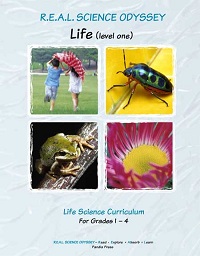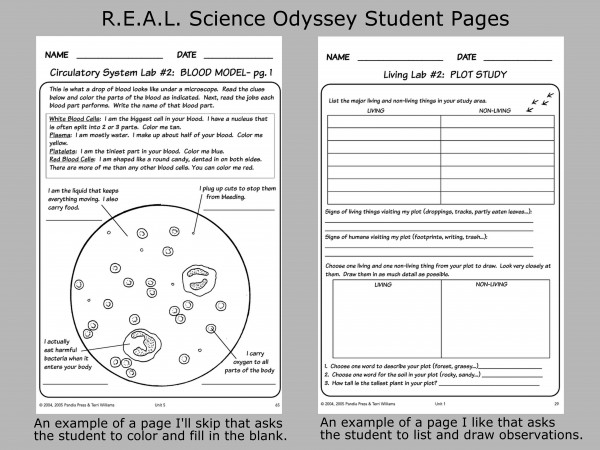Review: R.E.A.L. Science Odyssey Life Level One

Though not everyone views a formal science curriculum as necessary for children in early elementary years, I have a six year old son who loves all things science. We already did a lot of reading science books and watching scientific shows, but I wanted to spend more time on science in our homeschool and be sure I was covering basic building blocks of science knowledge for both him and his 10-year-old sister. I was excited to receive a copy of R.E.A.L. Science Odyssey Life Level One curriculum from Pandia Press to review. I had seen this curriculum online and was interested in seeing if it would be a good fit for our family.
What is it?
R.E.A.L. Science Odyssey is a science curriculum from Pandia Press. R.E.A.L. stands for read, explore, absorb, and learn. Life Level One is a full year of life science designed for grades 1-4. Each unit consists of a read-aloud lesson page followed over the course of the week (or longer, if needed) by hands on activities and labs that reinforce that lesson. There are student pages for your children to record what they’ve observed and the results of lab activities.
What works for us:
- The text for the lesson is not like a dry textbook, but more like a fun conversation with your cool scientist neighbor. The lesson page is informative but short and interesting enough to hold even my six-year-old’s attention.
- As a fan of Charlotte Mason and lover of good books I really appreciate the list of additional reading suggestions. It is especially handy because it marks which books are highly recommended versus just “more fun than science.” I attempt to request most of these from our library and feel it is a good supplement to the lesson text pages in the curriculum.
- The best part of this curriculum, and the reason it’s a great fit for our family, are the hands-on activities. Very little time is spent with me just talking to my kids about science, much more time is spent showing and doing and trying. As a line in the curriculum’s introduction states: “If you hate to touch “bugs,” wouldn’t think about letting your child handle worms and have no intention of getting gooey and dirty, RUN NOW!” You’ll be asked to bring critters into your home, build models, act out life cycles, and test different functions of your body. Many of the activities are easy to implement and may seem simple, but doing things really cements knowledge for my children.
What doesn’t work for us:
- We don’t usually use worksheets, so some of the printed pages intended for the student to fill out don’t work well for us. I skip the pages that include coloring or labeling the parts of a existing drawing, or simply have fill-in-the-blank questions. Drawing encourages my children to look carefully and pay attention to details. Many pages do have the child make a drawing of an observation and I use those, or if I skipped the included worksheet I simply give my children a blank piece of paper. If I had to estimate I would say I’m able to use roughly 80% of the student pages. Having the building blocks of science covered and hands-on learning activities planned out for me far outweighs not liking some of the printables.

- There are hand-drawn illustrations, but no real photos. In many instances you’ll be going outside to look for worms or a flower instead of needing a picture, but there are many items we don’t have easy access to. Internet searches or additional books will fill in the gap.
- I had to rearrange the order of the lessons. If we had done them in order we would have labs requiring worms, butterflies or other creatures from outside when in Maine the outside is buried in snow. I was nervous about this since the introduction discussed how the curriculum was meant to be used from start to finish with concepts building on one another, but I found it fairly simple to rearrange. The units are laid out this way: an introduction to the basis of life, then a study of the human body, followed by a study of the animal kingdom and then the plant kingdom. We did the introduction and moved into the animal kingdom (the last phylum covered is mammals), then we’ll spend much of the winter on the human body, and finish up with the plant kingdom in the spring when we can actually find signs of life outside.
The bottom line:
If you’re looking for an elementary level science curriculum that involves a lot of hands-on learning R.E.A.L. Science Odyssey may work for you. My kids are learning a lot and enjoy the activities. It’s simple to implement with easy-to-understand text and clear instructions for all labs and activities. Suggestions for supplemental books and websites are already included. This is a secular science curriculum, but other than a list of books covering evolution in the additional reading suggestions I didn’t find topics in this curriculum that would cause problems for Christian homeschoolers.
Check it out for yourself!
Pandia Press shows several preview pages for RSO Life Level One on their website, and there is also a larger preview to download. You can purchase the ebook directly from Pandia Press, or they have a list of retailers that sell the print version. I received the ebook and found it quite easy to use, with the added benefit of being able to print a copy of the student pages for each of my children.
 Hi, I'm Heidi and I homeschool my two sweet kids. I want them to know that learning is an exciting lifelong adventure! We love great books, unit studies, notebooking, lapbooking, and hands-on learning.
Hi, I'm Heidi and I homeschool my two sweet kids. I want them to know that learning is an exciting lifelong adventure! We love great books, unit studies, notebooking, lapbooking, and hands-on learning.



